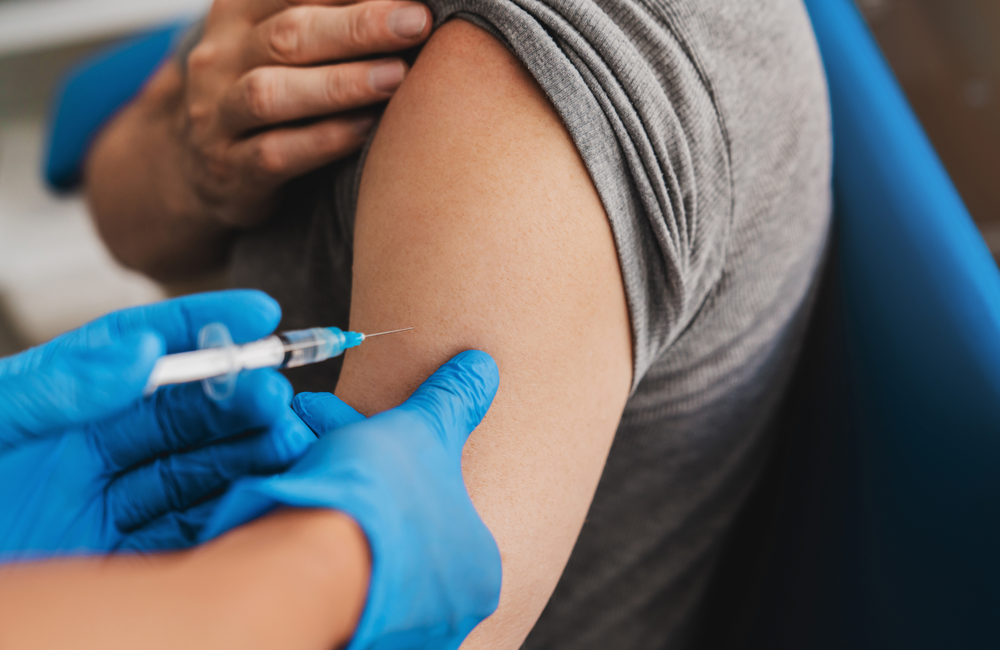
Receiving at least one dose of the MVA-BN vaccine significantly reduced the likelihood of being hospitalised with mpox (formerly known as monkeypox) for both HIV-positive and HIV-negative people, according to a study by the US Centers for Disease Control and Prevention and the California Department of Public Health, published in Morbidity and Mortality Weekly Report.
“To optimise durable immunity, all eligible persons at risk for mpox, especially those infected with HIV, should complete the two-dose [MVA-BN] series,” the study authors concluded.
As aidsmap previously reported, the UK Health Security Agency (UKHSA) detected the first cases in a new global mpox outbreak in May 2022. As of 31 August 2023, UKHSA has identified 3761 confirmed and probable cases in the UK. Worldwide, there have been more than 90,600 as of 27 September, resulting in 157 deaths, according to the World Health Organisation. Most mpox cases outside of Africa have been among gay, bisexual and other men who have sex with men.
Mpox case numbers have fallen dramatically since last year’s peak, though sporadic small clusters are still being reported. Experts attribute the decline to a combination of behaviour change, natural immunity after infection and vaccination.
Mpox is an orthopoxvirus closely related to smallpox, and the same vaccines provide protection against both viruses. The MVA-BN vaccine, sold as Imvanex in Europe and Jynneos in the US, was deployed in several countries during the 2022 outbreak, first as a subcutaneous injection and later -- in an effort to stretch the limited supply -- as an intradermal injection using one-fifth the original dose. Both administration methods require two doses given about four weeks apart. A recent global analysis found that although people who had mpox can get it again, and vaccination does not always prevent infection, past infection and vaccines confer partial immunity that reduces the risk of complications.
For the present study, Dr Samuel Schildhauer of the California Department of Public Health and colleagues looked at the effect of MVA-BN vaccination on the odds of hospitalisation after contracting mpox.
The researchers especially focused on people living with HIV, who are at higher risk for severe mpox disease. Previous CDC studies found that more than 80% of people hospitalised with severe mpox in the US had HIV, and most of those who died were Black gay men with AIDS. However, a recent analysis from the World Health Organisation found that HIV-positive people are not more likely to develop severe mpox unless they have advanced immune suppression.
Schildhauer’s team analysed surveillance data on all 5765 people with mpox reported in California between May 2022 and May 2023. Of these, 1154 were excluded due to missing hospitalisation data, leaving 4611 cases.
Most (94%) were cisgender men, just under 3% were cisgender women and about 1.5% were transgender. The median age was 35 years. More than three quarters identified as gay, bisexual or same-gender loving. About 45% were Latino, 29% were White, 13% were Black and 5% were Asian. Consistent with prior US studies, 41% were living with HIV (somewhat higher than the proportion in the UK).
As a limitation of the analysis, the study authors noted that there were some differences between included cases and those excluded due to missing hospitalisation data in terms of race/ethnicity, sexual orientation and HIV status. Of note, people with diagnosed mpox likely represent a population with better access to health care than those who were never diagnosed, and people with more severe cases would have been more likely to seek care than those with mild illness.
Within this group, 230 received a single MVA-BN vaccine dose at least 14 days prior to symptom onset, specimen collection or a positive lab test (whichever was earlier). People who received two doses less than 24 days apart or who got their second jab less than two weeks before developing mpox were counted as having had a single dose. Another 79 people received two correctly spaced doses at least two weeks before an mpox episode. A larger number, 457, received the vaccine as post-exposure prophylaxis after a known or suspected exposure. This left 3,845 people unvaccinated.
A total of 250 people with mpox were hospitalised, including 140 people living with HIV. Most (233) were unvaccinated, four had received a single pre-exposure vaccine dose and one had received two pre-exposure doses, while 12 had received the vaccine as post-exposure prophylaxis. Although people with HIV made up 41% of the mpox cases, they accounted for 56% of hospitalisations.
The researchers found that the odds of hospitalisation were lower for people who received one or two pre-exposure MVA-BN doses. Overall, vaccine effectiveness was 73% for a single dose and 80% for two doses compared with being unvaccinated. Among people with HIV, one dose was 72% effective; no HIV-positive people who received two doses were hospitalised. Post-exposure vaccination was somewhat less effective, at 58%.
“These findings suggest that receipt of both pre- and post-exposure Jynneos vaccination reduces the odds of hospitalisation among persons with mpox,” the study authors wrote.
Since May 2022, an estimated 64% of California’s at-risk population has received one dose of the vaccine and 40% have received two doses, leaving a substantial proportion without full protection.
“Messaging to persons at higher risk for Monkeypox virus infection and persons with HIV infection should encourage completion of the two-dose Jynneos vaccination series to limit virus transmission and mitigate disease severity,” the researchers added.
Schildhauer S et al. Reduced odds of mpox-associated hospitalization among persons who received JYNNEOS vaccine — California, May 2022–May 2023. Morbidity and Mortality Weekly Report, 8 September 2023 (open access).
